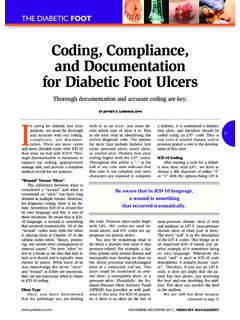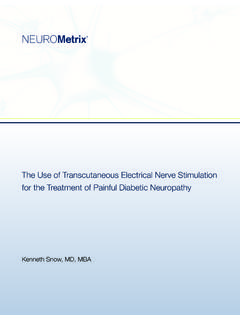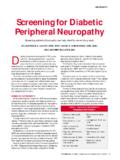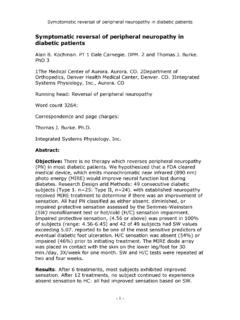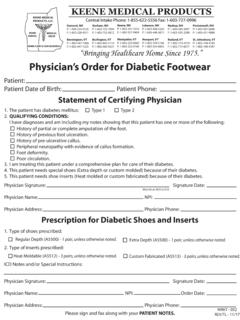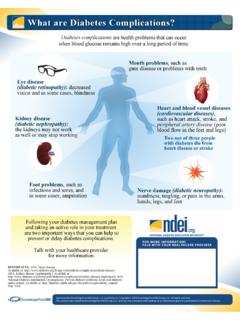Transcription of Coding, Compliance, and Documentation for …
1 2017 | PODIATRY MANAGEMENT 71a diabetic , it is considered a diabetic foot ulcer, and therefore should be coded using an L97- code. This is true even if arterial disease and/or pressure played a role in the develop-ment of this Coding After starting a code for a diabet-ic foot ulcer with L97-, we have to choose a 4th character of either 4 or 5 with the options being (non-pressure chronic ulcer of heel and midfoot) or (non-pressure chronic ulcer of other part of foot). The word and is in the description of the codes.
2 This brings us to an important ICD-10 lesson and an-other example of it sometimes being its own language. Whenever the word and is used in ICD-10 code descriptions, it actually means and/or . Therefore, if you use an code, it does not imply that the pa-tient has two ulcers, one involving the heel and one involving the mid-foot. The ulcer can involve the heel or the midfoot. We are still not done because In caring for diabetic foot ulcer patients, we must be thorough and accurate with our coding, compliance, and documen-tation.
3 There are more codes and more detailed codes with ICD-10 than what we had with ICD-9. Thor-ough Documentation is necessary to support our coding, appropriately manage risk, and provide a complete medical record for our patients. Wound Versus Ulcer The difference between what is considered a wound and what is considered an ulcer has been long debated in multiple forums. However, for diagnosis coding, there is no de-bate. Sometimes ICD-10 is almost like its own language and this is one of those situations.
4 Be aware that in ICD-10 language, a wound is something that occurred traumatically. All of the wound codes start with the letter S, placing them in Chapter 19 of the tabular index titled, Injury, poison-ing, and certain other consequences of external causes . The term ulcer re-fers to a break in the skin that fails to heal as it should and is typically more chronic in nature. While many of us may interchange the terms ulcer and wound as if they are synonyms, they are not synonyms when it comes to ICD-10 Type Once you have determined that the pathology you are dealing with is as an ulcer, you must de-cide which type of ulcer it is.
5 This is the next step in identifying the correct diagnosis code. The options for ulcer type include diabetic foot ulcer, pressure ulcer, stasis ulcer, or arterial ulcer. diabetic foot ulcer coding begins with the L97- codes. Throughout this article a - at the end of any code stem indicates that this code is not complete and more characters are required to complete the code. Pressure ulcer codes begin with L89-. I83- codes are used for stasis ulcers, and I70- codes are ap-propriate for arterial ulcers.
6 You may be wondering what to do when a diabetic foot ulcer is also pressure-related. For example, a dia-betic patient with arterial disease and neuropathy may develop an ulcer on the dorsal proximal interphalangeal joint of a contracted 2nd toe. This ulcer could be considered an arte-rial ulcer, a neuropathic ulcer, or a pressure ulcer. Thankfully, the Na-tional Pressure Ulcer Advisory Panel (NPUAP) has provided us with guid-ance in this area. For ICD-10 purpos-es, if there is an ulcer on the foot of Thorough Documentation and accurate coding are , Compliance, and Documentation for diabetic Foot UlcersBy Jeffrey D.
7 Lehrman, DPmBe aware that in ICD-10 language, a wound is something that occurred on page 72 THE diabetic 2017 | PODIATRY MANAGEMENT 72 THE diabetic fOOTditional code. If the patient is on diabetic medication, the and/or code should be listed after If this is not something you have been asking your type 2 dia-betic patients, you may be surprised how many type 2 diabetics are now taking insulin as compared to ten or more years ago. If the patient is not on any type of diabetic medication, neither of these need to be coded.
8 If the patient is on both types of diabet-ic medication, both of these should be coded. If the patient is a type 1 di-abetic, you will see that does not carry this instruction to use a z code. Let s go through the diagnosis coding of a type 2 diabetic patient taking daily insulin for a chronic left lateral midfoot ulcer with ne-crosis of muscle. When coding this encounter, you would start with because this ulcer is on the midfoot. The 5th character would be 2 because it is the left foot, and the 6th character would be 3 because there is necrosis of muscle.
9 That leaves us with , which carries the instruction to code first (type 2 diabetes mellitus with foot ulcer). Because this patient uses daily insulin, is necessary as well. Following the rules of code first and use additional code , the order of these codes would be first, second, and Coding After the diagnosis code is com-plete, the next step is to identify the Current Procedural Terminolo-gy (CPT) code for the debridement that was performed. There are four once you have decided on a 4th character, a 5th character is required and the 5th character options are listed in Table 1.
10 This code is not complete after selecting the 5th character because a 6th character is required. The 6th character codes are listed in Table 2. You will notice the unspecified options in these 5th and 6th character listings. An unspecified selection indicates to the payer that the Documentation was incomplete, and should almost always be avoided as this may lead to denial of payment. With the 5th character laterality options, for ex-ample, a selection of 0 would in-dicate that neither left nor right was specified in the Documentation .
